One of the most important aspects of any wearable sleep or fitness tracker is its accuracy. Without reliable data, these devices range from gimmicky to useless. So for this article, I wanted to take a closer look at WHOOP — the wrist-worn fitness tracker I’ve been using since 2019 — to find out just how accurate it really is.
In a nutshell, my research and first-hand testing shows that WHOOP is highly accurate in the following areas:
- Heart rate variability (HRV)
- Recovery
- Respiratory rate
- Resting heart rate
- Sleep quality and stages of sleep
However, you might experience mixed results with heart rate tracking during certain types of exercises and activities, especially when they involve lots of wrist movement.
If you’re new to WHOOP and wondering whether it’s the right fitness tracker for you, I encourage you to read my hands-on WHOOP review (or watch the video review below) for more background on the device’s features, capabilities and limitations.
WHOOP Heart Rate Sensor Accuracy
The best way to determine the accuracy of a wrist-worn heart rate sensor is to simultaneously use a three-lead electrocardiogram (ECG) and then compare the two sets of data. The second-best way is to use a chest strap, which doesn’t rely on photoplethysmography and instead measures the electrical signals emitted by your heart as it beats.
One thing that’s worth mentioning is that both the sensor and the open-source algorithm used by WHOOP to interpret the raw data and convert it into “heartbeats” are pretty standard across the industry.
Wrist-worn devices such as WHOOP rely on light-emitting diodes (LEDs) that shine light through your skin and onto your blood vessels. Interpreting the light signal as it bounces back from your skin is an analog process, and is thus subject to interference and signal noise.
A study funded by the Australian Institute of Sport (AIS) found that WHOOP was 99.7% accurate in measuring heart rate and 99% accurate in measuring heart rate variability when compared to the gold-standard electrocardiogram-derived (ECG) metrics.
While that sounds pretty good, it’s worth noting that those measurements were taken under conditions ideal for wrist-worn devices that might not reflect your circumstances.
For example, a dark tattoo can absorb some of the emitted light, thus altering how much of the light is reflected back to the sensor. Similarly, dark skin has more pigments (such as melanin) which absorb more of the laser light, potentially leading to less-reliable readings.
Factors that can negatively influence the accuracy of WHOOP and similar wrist-worn devices include:
- A loose strap that has insufficient contact between the sensor and the skin.
- Wrist movement that temporarily breaks contact between the sensor and your skin.
- Body motion that the sensor might interpret as heart contractions.
- The ambient temperature and your body temperature, both of which influence blood flow.
- Variables that can interfere with the reading of the reflected light (e.g., your skin color or tattoos).
These factors make it difficult for WHOOP to accurately detect your heart rate in less-than-ideal conditions. That’s particularly true in situations where your heart rate changes a lot, like during CrossFit or other types of high-intensity interval training (HIIT).
Factors That Can Negatively Impact WHOOP’s Heart Rate Tracking
So let’s talk about each of these to see how they influence WHOOP’s accuracy, and explore any potentially mitigating factors.
Strap Fit
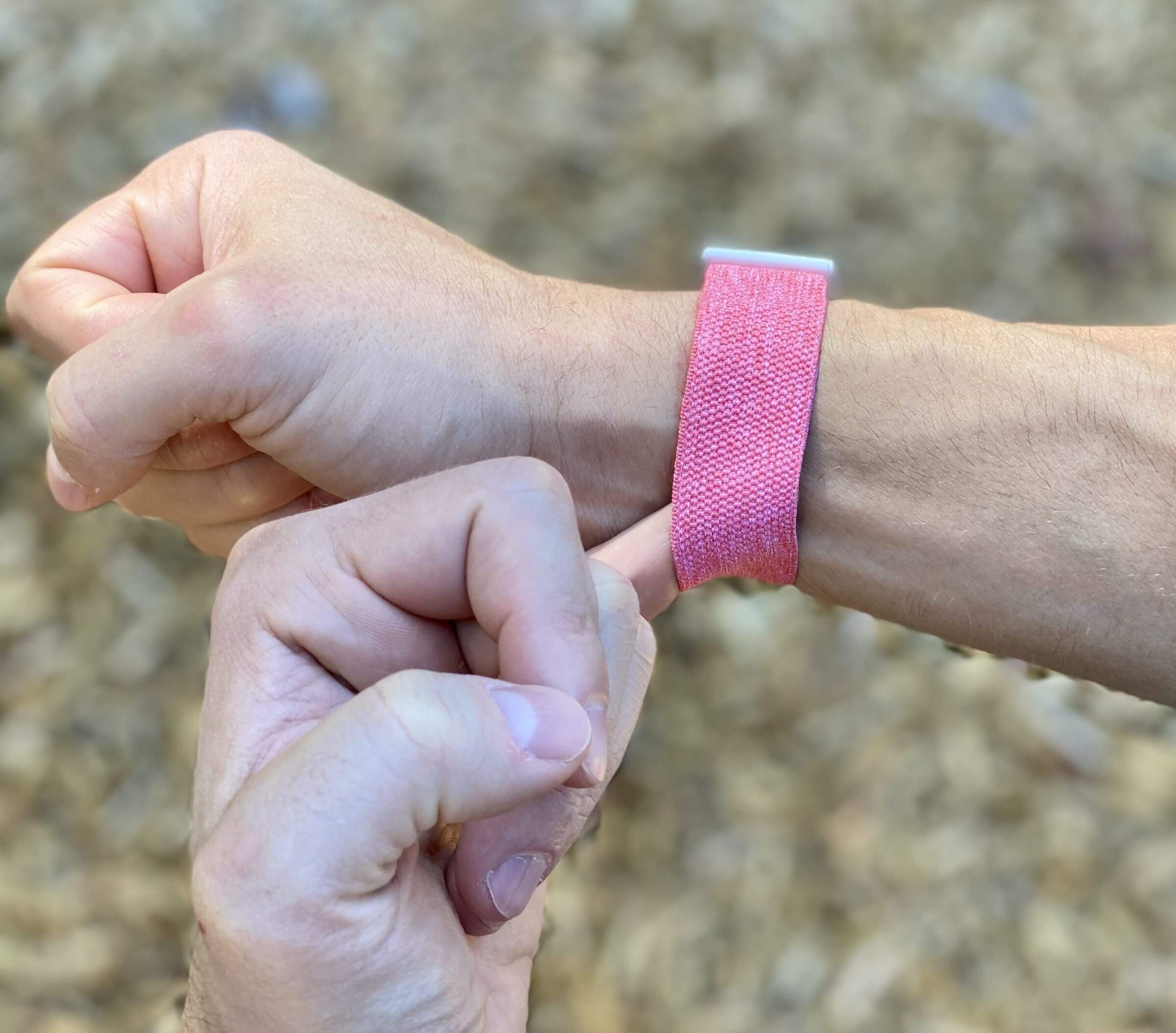
WHOOP’s sensor needs to be in close contact with your skin at all times. Otherwise, it won’t be able to accurately measure your heart rate or other biometrics.
That’s why it’s so important to use a strap that provides a secure fit. It should be tight enough that you can place your pinky finger between the strap and your skin with no excess space (as shown in the photo above).
Be sure not to over-tighten the strap, because doing so can restrict your blood flow and cause issues.
WHOOP seems to have realized that strap fit is a crucial factor in ensuring accuracy, as the company released its SuperKnit strap together with the WHOOP 4.0. SuperKnit is an incredibly comfortable and infinitely adjustable strap that makes it easy to keep the WHOOP sensor in close contact with your skin at all times.
If you do CrossFit or similar exercises that involve gloves, gymnastic grips, dumbbells or a lot of wrist movement, WHOOP Body (a special line of activewear that enables you to wear the sensor on your arm or hip) might actually be the better choice.
Skin Color and Tattoos
WHOOP’s optical heart rate sensor relies on the reflection of light that’s emitted by the sensor’s LEDs. Anything that can interfere with the frequency of the emitted light or its reflection can introduce noise and render the signal less accurate.
Examples of this include ambient light that reaches the sensor due to an improper fit or tattoos.
Note that WHOOP 4.0 includes a pulse oximeter that uses red and infrared light, both of which are less prone to interference from skin pigments or tattoos. However, WHOOP only uses the pulse oximeter for sleep tracking, because it’s prone to interference by movement.
Wrist Movement
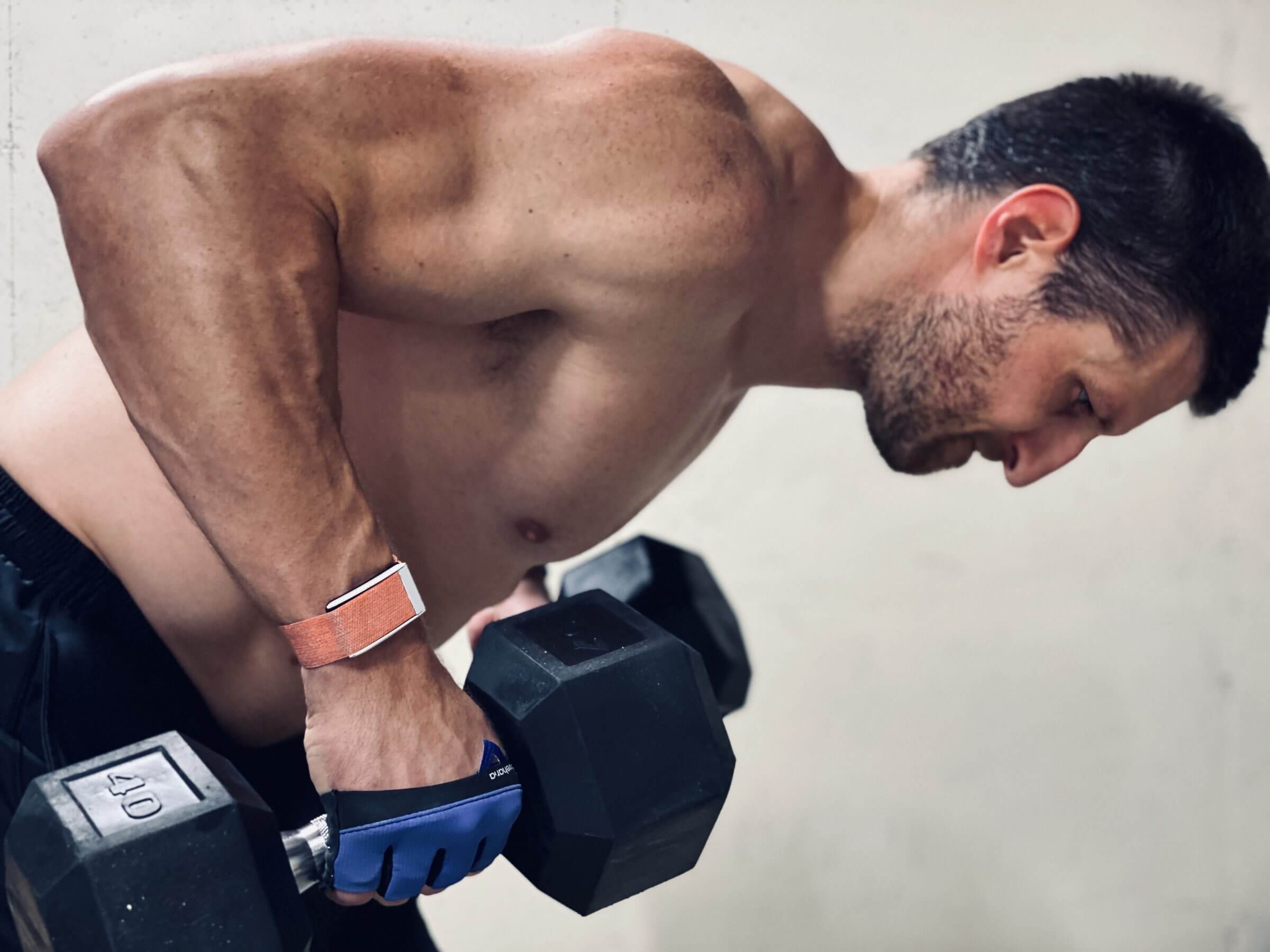
Any time you move your wrist, you risk the sensor temporarily losing contact with your skin. If that happens, you’re likely to get some inaccurate heart rate readings. When that occurs during a time when your heart rate changes a lot (e.g., dumbbell interval training), you might see a huge gap between your actual HR and what WHOOP recorded.
The best way to mitigate issues related to wrist movement is to wear the sensor on another part of your body by using WHOOP Body.
Body Movement
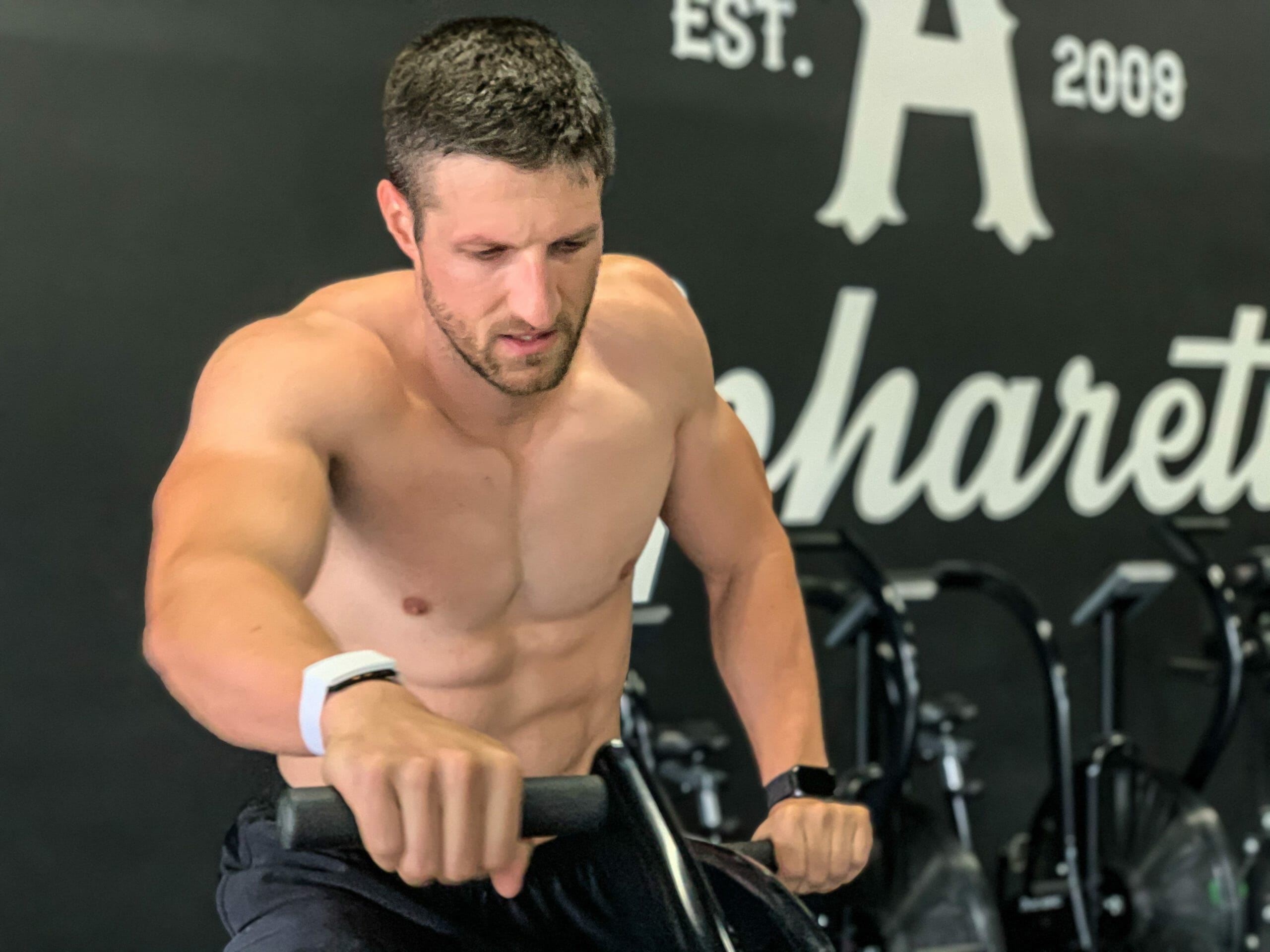
One thing you might not have known is that WHOOP (and other optical HR sensors) also rely on the accelerometer to detect the contractions of your heart and the force of the blood flowing through your blood vessels.
As you can imagine, the accelerometer picks up a lot of “noise” during exercises, such as steps taken, jumps, and any other movement. WHOOP has to distinguish between those different input sources and filter out the ones related to your heartbeat.
While differentiating between the motion induced by continuous movements — such as jogging or walking — and your heartbeat is relatively easy, it’s much more difficult for fast-paced movements like CrossFit.
But I’ve also heard reports that even monotonous movements like biking can throw off an optical HR sensor, because the way the muscles contract during biking can be misinterpreted as a contracting heart.
Obviously, the same holds true for other wrist-worn devices, such as the ones from Fitbit, Biostrap, Polar, Garmin and other brands.
The best way to mitigate that issue is to move the sensor to your hip by wearing WHOOP’s special underwear or shorts (part of the WHOOP Body line)
Ambient and Body Temperature
Most wrist-worn sensors seem to do better in warmer temperatures. That’s because if it’s too cold, the body restricts capillary blood flow, making it more difficult for the sensor to get a good reading.
So if it’s cold outside, I recommend wearing extra layers or warming up sufficiently before you begin measuring your heart rate.
WHOOP Calorie Burn Accuracy
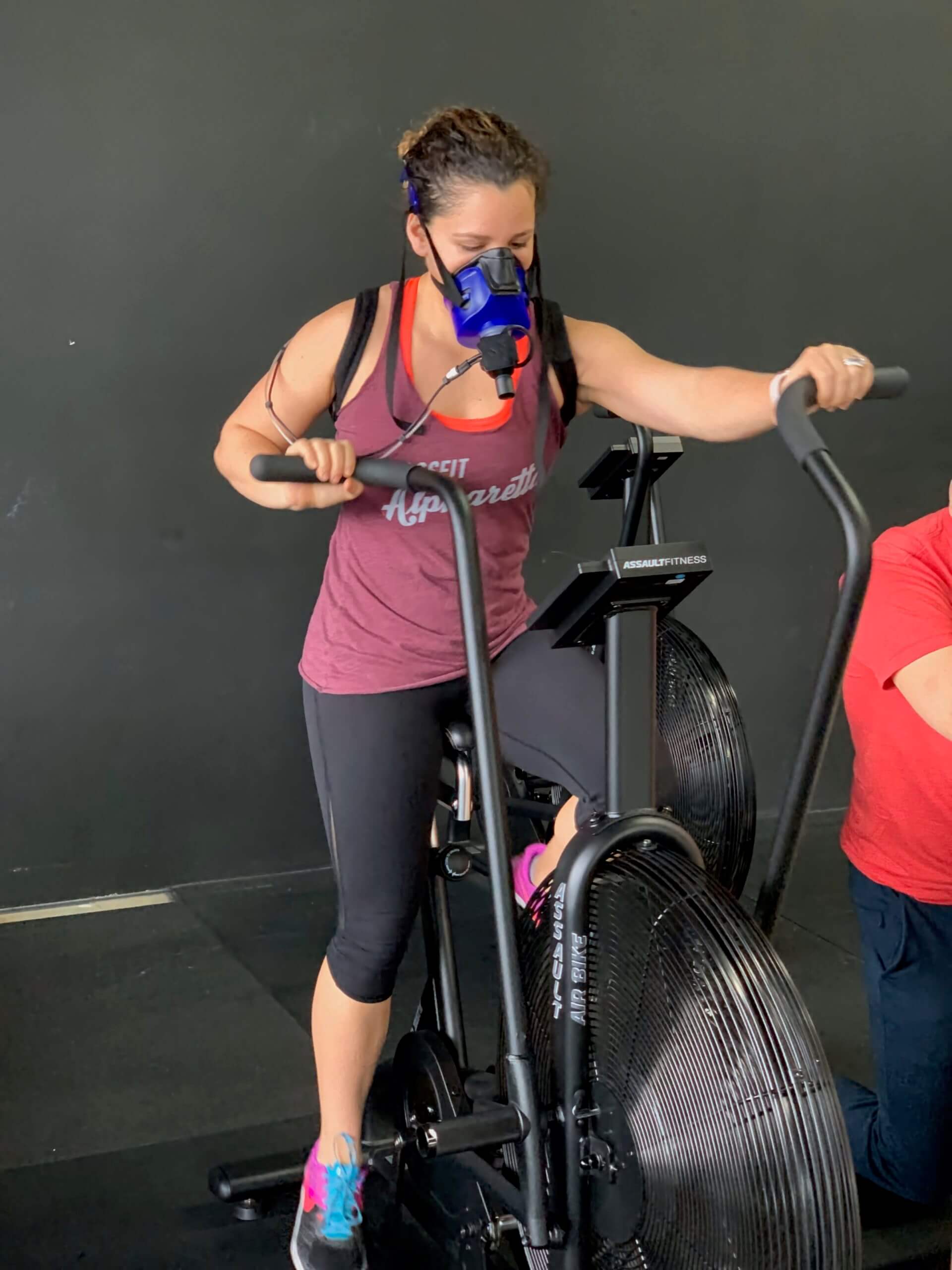
Accurately tracking how many calories you burn is incredibly difficult without first establishing your basal metabolic rate (BMR), which involves wearing a face mask that measures how much oxygen you inhale and how much carbon dioxide you exhale.
That’s not something you can easily do at home without the proper equipment.
Instead, what most fitness trackers do is try and predict your BMR based on height, weight, age, and biological sex. While doing so often yields satisfactory results, predicting the active burn is much more difficult.
WHOOP uses a heart-rate-based formula to estimate active burn, which utilizes a model developed in South Africa in 2005. You can read more about the challenges of predicting BMR and active calorie burn on the WHOOP blog.
The bottom line is that a wrist-worn device can’t accurately predict your absolute calorie burn, so don’t get hung up on the numbers reported in the WHOOP app.
However, WHOOP can accurately record relative changes in calories burned, which can be helpful if you want to compare rest days vs. workout days, or the impact of different types of workouts, on your calorie burn.
A few years ago, WHOOP announced a partnership with PNOE, a company that makes hardware and software to calculate basal metabolic rate (BMR). I was hoping they’d announce an integration shortly thereafter, but so far nothing has come out of this partnership.
WHOOP Strain Tracking Accuracy
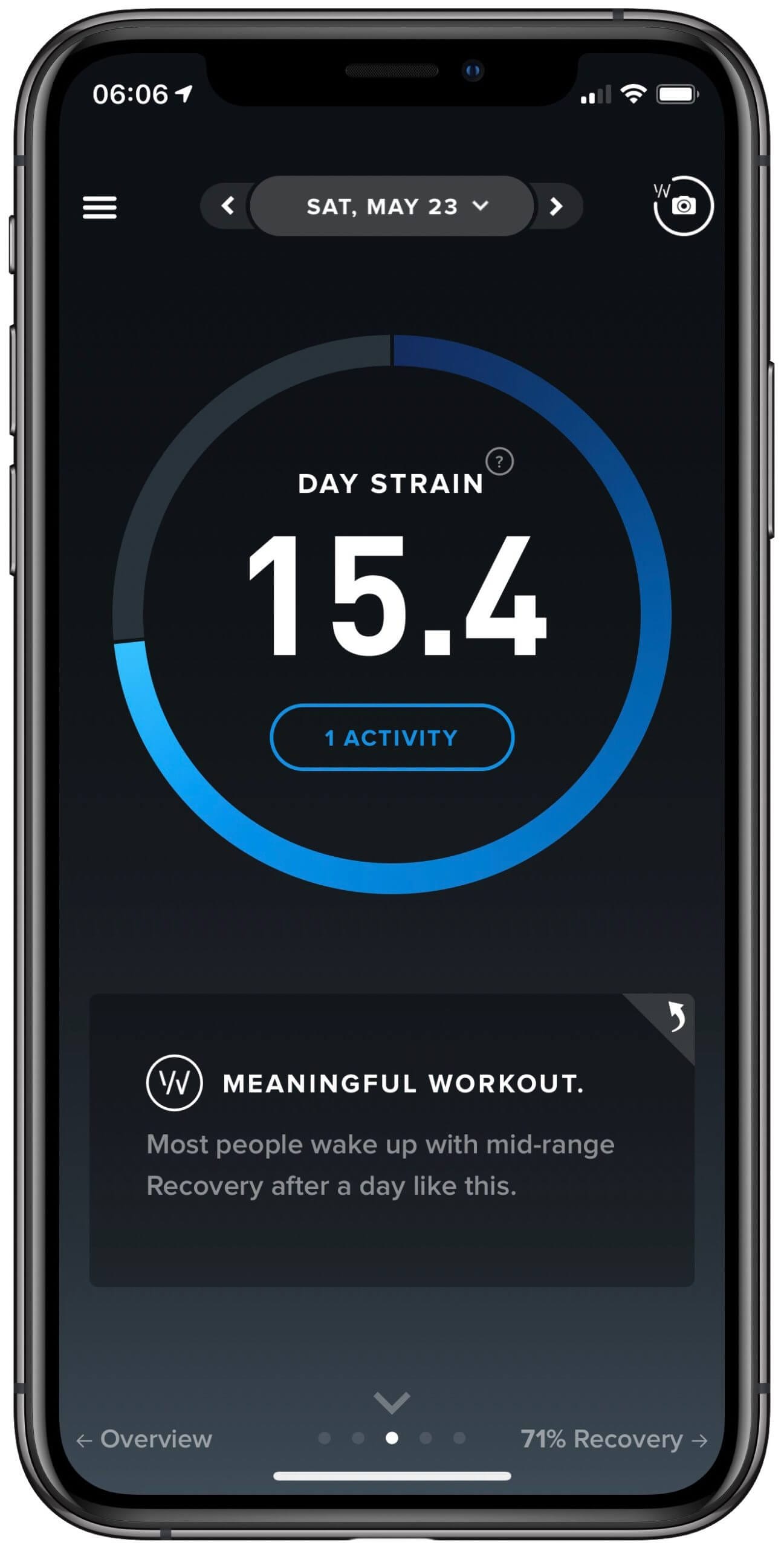
The strain metric in the WHOOP app gives you insight into how much load you’ve placed on your cardiovascular system through exercise or other daily activities that might elevate your heart rate.
As you can imagine, the strain score is highly dependent on an accurate heart rate reading. As a result, certain types of physical activities cause slightly inaccurate strain scores.
What many WHOOP users don’t understand is that the strain score doesn’t impact the recovery score, because the latter is predominantly influenced by your heart rate variability, resting heart rate, and quality of sleep.
WHOOP Sleep Tracking Accuracy
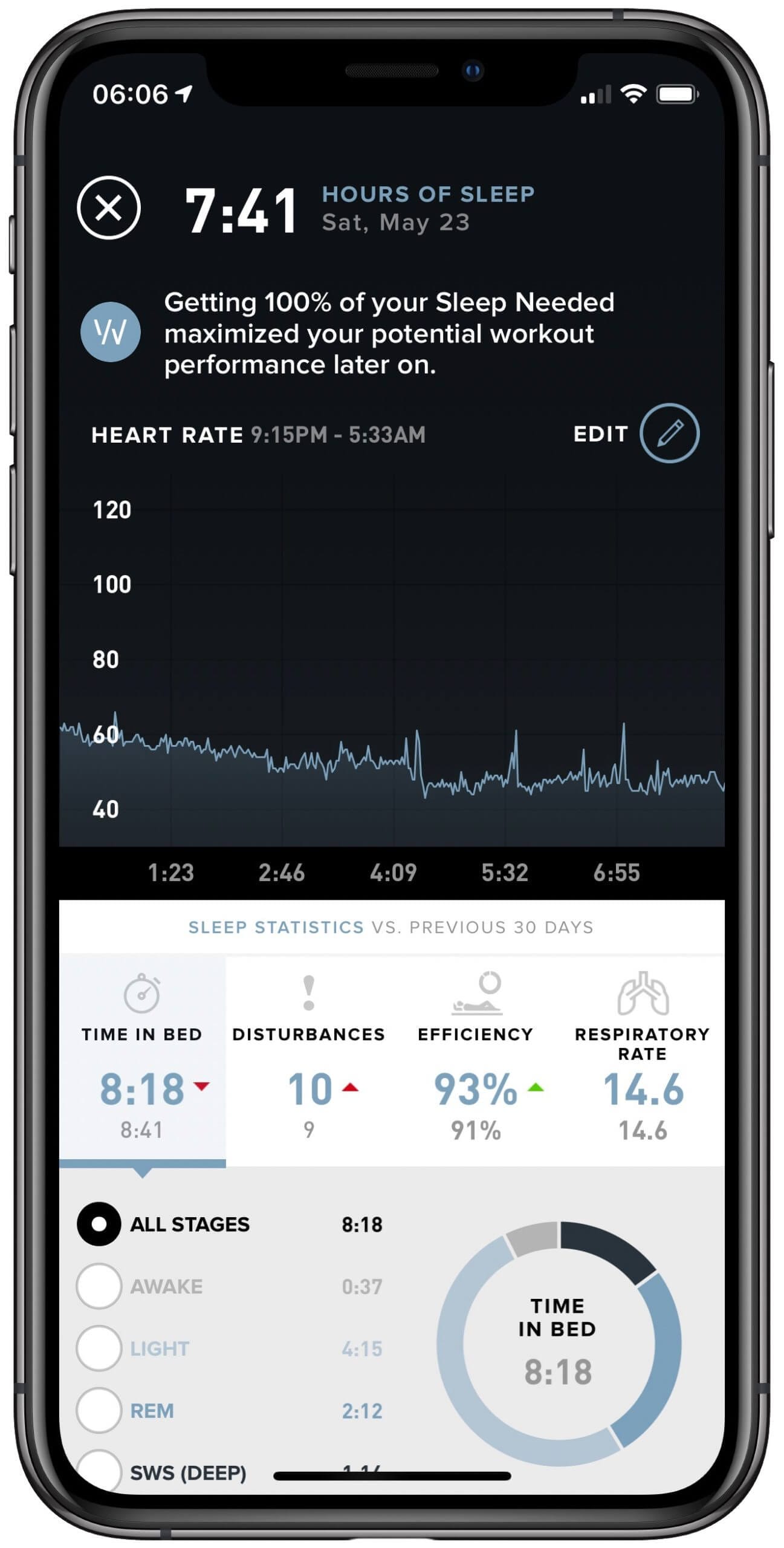
As I mentioned in my WHOOP review, the device is an incredibly accurate sleep tracker (as confirmed by validation studies).
Since sleep tracking relies on an accurate heart rate reading (along with other biometrics), how is it possible that WHOOP can do that so accurately?
The reason is simple: your movement pattern is vastly different while sleeping vs. while exercising. In fact, during the restorative phases of sleep, you might not move at all. That makes it incredibly easy for WHOOP to take accurate heart rate measurements.
Considering the excellent results shown in various validation studies, it’s safe to assume that the hardware sensors packed into WHOOP can accurately track your biometrics while you sleep.
One thing I’ve seen other people complain about is WHOOP’s supposedly unrealistic recommendations on when to go to bed and how long to sleep.
Based on my understanding of how the “sleep need” figure is calculated, and my experience with the “sleep coach,” I don’t think the recommendations are unrealistic at all. What most people don’t understand is that sleep debt is cumulative.
So if you’ve been sleeping an hour less than your body needs over the course of three weeks (for example), you can expect a higher sleep need for the next few days or even weeks. Sleep debt doesn’t just go away because you want it to.
If you’d like to learn more about the technology behind WHOOP’s sleep tracking capabilities, check out my list of the best sleep trackers and scroll down to the WHOOP section.
How Accurate Is the WHOOP Recovery Score?
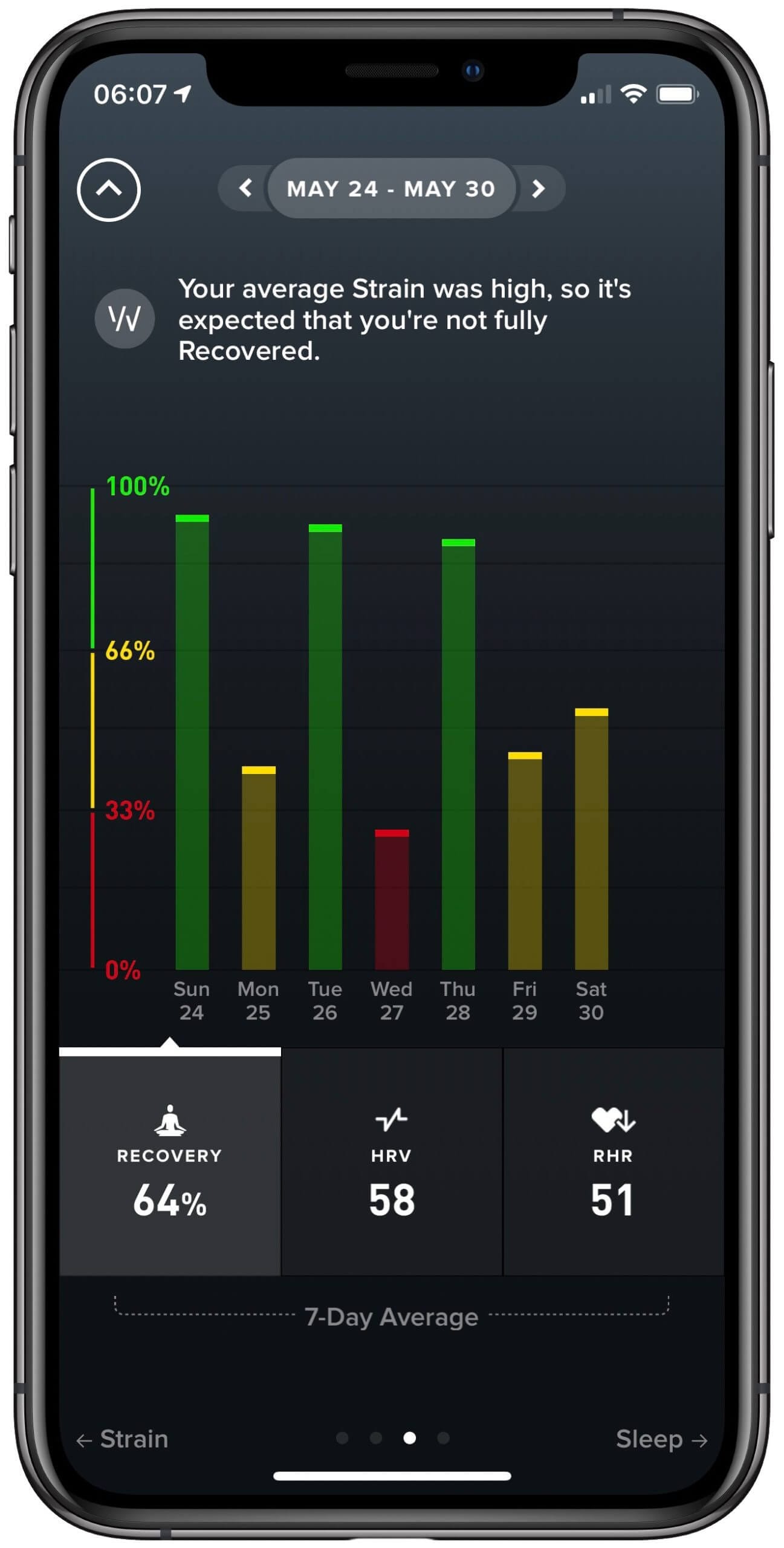
The recovery score is so accurate and useful that I’d be wearing WHOOP even if that was the only feature it offered.
Many WHOOP users, and even other reviewers, don’t fully understand how the recovery score is calculated. What’s important to recognize is that the previous day’s strain score has zero influence on your recovery the next day.
Instead, the recovery score is a reflection of how your nervous system is doing. To find that out, WHOOP measures your HRV during the last phase of deep sleep. That’s the time when your brain is most “disconnected” from the rest of your body, preventing movement or other influencing factors.
We already know that WHOOP is incredibly accurate when the conditions are right, and deep sleep (also called slow-wave sleep) is the perfect condition to take RHR and HRV measurements.
Why I Don’t Care About Activity Tracking
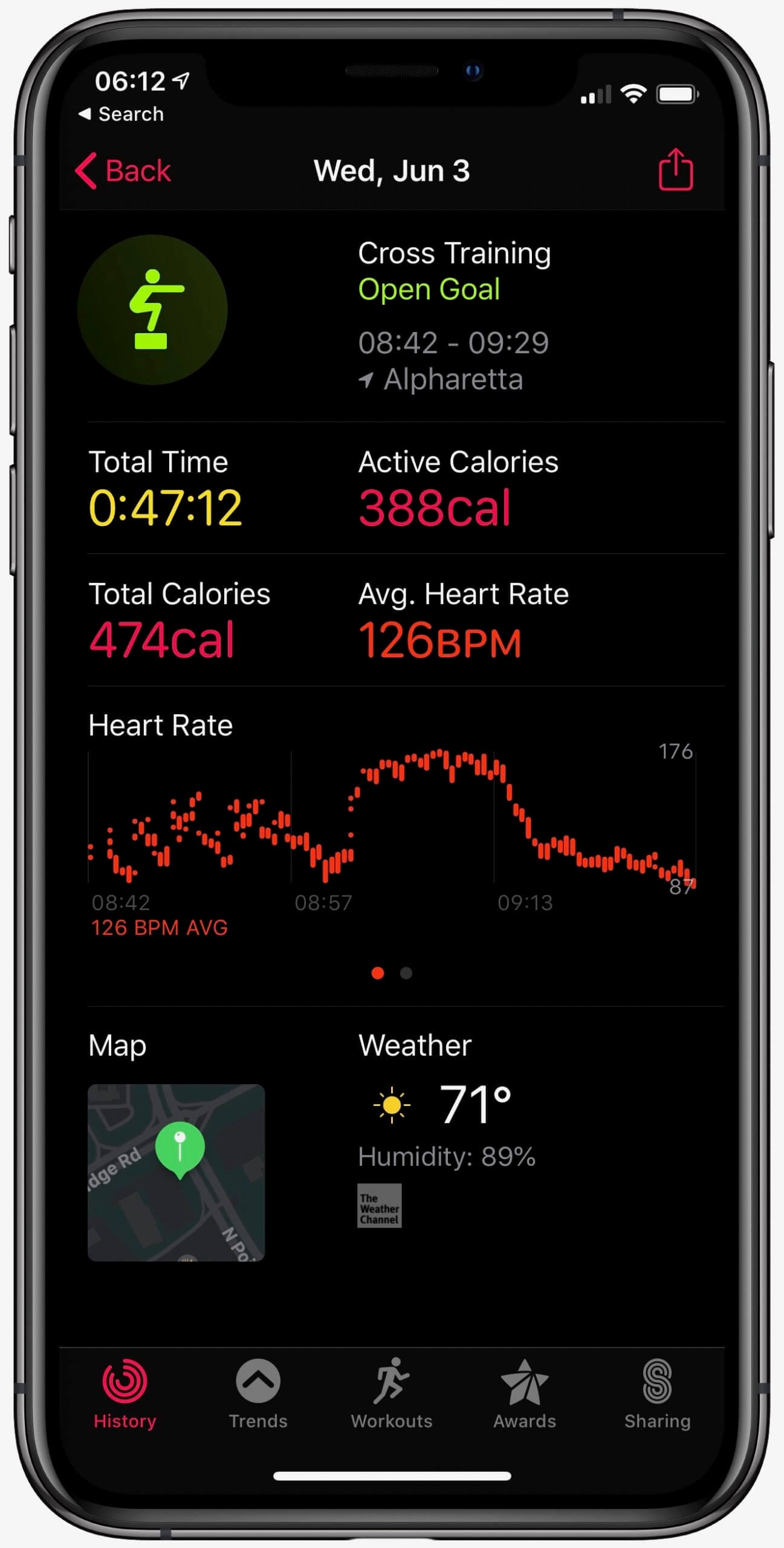
Now that you know everything there is to know about WHOOP’s accuracy, let me tell you why the areas where WHOOP shows weaknesses are irrelevant to me.
I’m no longer a professional athlete. I’m a serious fitness enthusiast and I wear WHOOP to help me improve my overall health and well-being. Having insights into the quality of my sleep, including what factors influence it and the condition of my nervous system, helps me make better decisions throughout the day.
What doesn’t help me is knowing how many calories I burned, or if my strain on a given day was 13 or 14. Those are nice parameters to know, but they don’t significantly influence my behavior.
Of course, there are some exceptions to this. For example, if my strain is consistently high despite not having exercised, I might have to work on reducing my stress (which is a common cause of an elevated strain score). But beyond that, I care more about my recovery score, my HRV/RHR trends, and how much restorative sleep I get.
These are factors that WHOOP can accurately report on. And they’re the ones that I can directly influence based on my lifestyle choices.
If you’re a professional athlete and you keep tabs on strain and calories burned to plan your meals and workouts, then you might need a separate chest strap to measure your heart rate during exercise. Unfortunately, WHOOP doesn’t currently allow the use of third-party HR sensors.
Despite the fact that I don’t really care about activity tracking, I wanted to find out how WHOOP compares to a chest strap heart rate monitor in order to share that information with you.
My WHOOP vs. Chest Strap Experiment
I decided to do a little experiment and wear a Wahoo chest strap during a brisk outdoor walk and a typical CrossFit workout involving various movements that caused my HR to change rapidly.
Shoot me an email If you want to find out exactly how I set up the test. In a nutshell, I connected the chest strap to my Apple Watch, enabled real-time HR broadcast in the WHOOP app, and recorded WHOOP’s HR data using the Wahoo Fitness app. Both sources stored their data in Apple’s Health app, which is where I extracted it from.
The results were pretty much as I expected.
Brisk Outdoor Walk
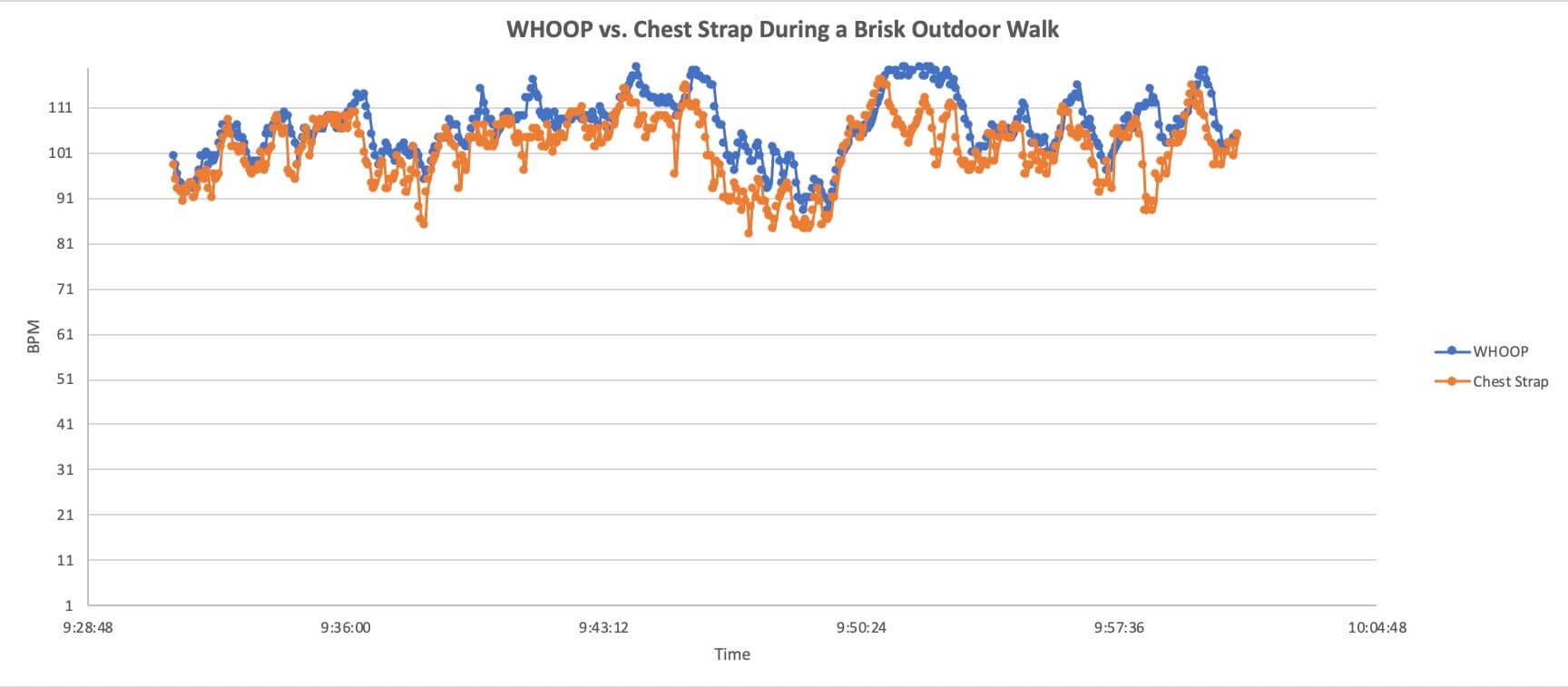
WHOOP was relatively accurate in comparison to the chest strap during my brisk outdoor walk. On average, WHOOP was only off by 3.8 beats per minute.
Here’s a better representation of how close WHOOP’s HR data was to the chest strap. I should point out, however, that the Wahoo app only recorded one HR event every four seconds, whereas the chest strap/Apple Watch combo recorded an event every second.
| Δ HR | % |
|---|---|
| Within 25 BPM | 100% |
| Within 10 BPM | 95% |
| Within 5 BPM | 74% |
| Within 3 BPM | 52% |
You can see those discrepancies in the graph below — particularly in the areas where my HR rapidly changed.
CrossFit Workout
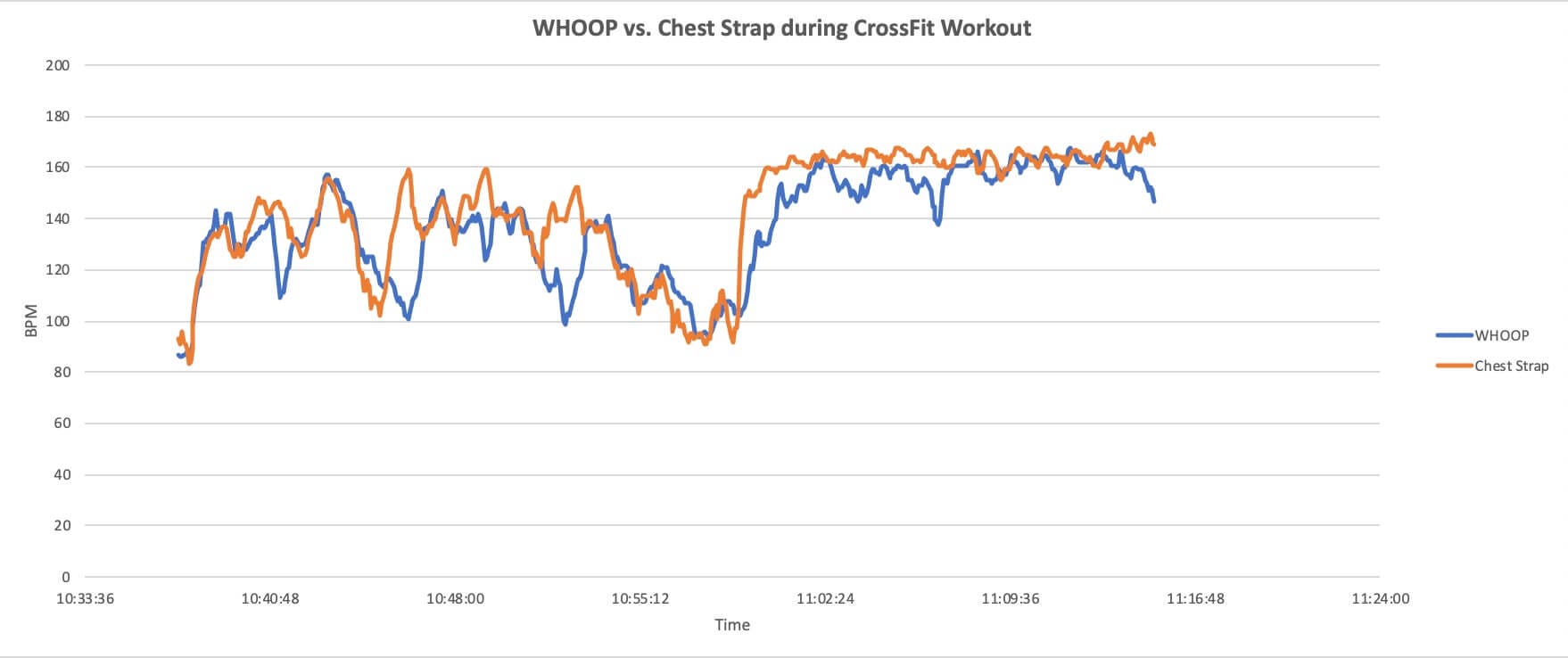
As expected, the HR deltas were wider during a high-intensity workout that involved dumbbells, push-ups, thrusters and box step-overs with rest periods in between rounds.
In other words, the WHOOP sensor and algorithm had to deal with a rapidly changing heart rate, a lot of irregular motion, and wrist movement. It’s kind of a nightmare scenario for any wrist-worn fitness tracker.
| Δ HR | % |
|---|---|
| Within 25 BPM | 96% |
| Within 10 BPM | 81% |
| Within 5 BPM | 58% |
| Within 3 BPM | 40% |
As you can see in the table above, there’s a noticeable spread between what the chest strap recorded and what WHOOP thought my heart rate was.
WHOOP Accuracy FAQs
Based on my testing, WHOOP 4.0 is more accurate than WHOOP 3.0 as far as heart rate tracking during exercise and sleep tracking are concerned. That’s likely because of the additional sensors that are included in the new version, and the ability to wear the device on your body (via WHOOP Body garments). You can learn more about the difference between the two versions in my WHOOP 4.0 review.
While the device was designed to be worn 24/7, doing so is not always necessary, depending on your tracking goals. For example, sleep tracking isn’t negatively impacted if you don’t wear WHOOP during the day. Vice versa, you can track your workouts during the day without wearing WHOOP for sleep. However, to get the most complete picture of your daily activities, including strain, recovery and sleep, I recommend wearing WHOOP 24/7.
Yes! For WHOOP to capture accurate heart rate data it’s important for the sensor to remain in close contact with your skin. Certain exercises that involve wrist movements, including kickboxing and CrossFit, make it difficult for the sensor to remain in contact with your skin, thus reducing WHOOP’s accuracy. As a result, I recommend considering wearing WHOOP on your arm or hips (using the bicep strap or WHOOP Body garments) to improve accuracy.
WHOOP accurately reports certain biometrics right away, including strain and sleep. However, certain metrics, such as recovery or your daily health report, take a bit longer to become meaningful because WHOOP has to establish a baseline first. Depending on the specific biometric, WHOOP needs somewhere between a week and 30 days to establish a meaningful baseline.
Depending on the particular biometric you want to verify, I recommend a chest strap heart rate monitor or a sleep lab to identify inaccurate data. Since most of us don’t have easy access to a sleep lab, I usually gauge WHOOP’s sleep tracking accuracy by comparing it to other sleep trackers and based on how I feel in the morning.
The best thing you can do is ensure that the WHOOP sensor remains in close contact with your skin by tightening your strap or wearing the sensor on your arm or hip via WHOOP Body garments.
Final Verdict: WHOOP Is Very Accurate in the Areas That Matter
Based on my use cases and requirements, the WHOOP strap is accurate in the areas that matter most to me, including recovery and sleep tracking. In other areas, WHOOP has the same limitations as other wearables, and it might not always track your heart rate as accurately as a chest strap or an ECG.
So if you’re a professional endurance athlete who relies on super-accurate HR data for training and competitions, you will have to use a chest strap. There’s no way around that.
However, a chest strap doesn’t provide any of the other benefits of the WHOOP strap, including detailed sleep stage and recovery tracking. So you might end up with both a chest strap and a WHOOP.
I’m a hobby CrossFitter and usually don’t care about tracking my workouts on my Apple Watch or WHOOP. I just want to know how recovered I am and how I slept. Those are the factors that determine how I plan my day.
If you want to give WHOOP a try, use this link and get an extra month added to your new membership.

Michael Kummer is a healthy living enthusiast and CrossFit athlete whose goal is to help people achieve optimal health by bridging the gap between ancestral living and the demands of modern society.
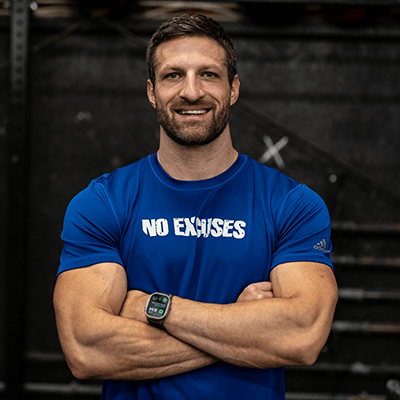

Is it possible for the Whoop to give abnormally high heart rate readings when doing simple activities like driving or watching a movie? My daughter had been recording HRs of 160 while driving or sitting at her desk working. It has been alarming to her. She visited the cardiologist and wore a holter monitor and has had other heart tests which show no cardiac problems. Would this indicate defects in the device or placement of the Whoop? Is there a way to verify its accuracy?
Hey Karen,
The high HR could be caused by vibrations (I noticed it when chopping food in the kitchen or using a hammer), an improper (too loose) fit or a defective device. You could get her a chest strap HR monitor to compare the readings.
Cheers,
Michael
I personally haven’t been impressed with the accuracy of any of the measurables. That may be, in part, to the type of work I do. 24 hour shift with multiple interruptions to sleep overnight. After a work night where I have 3-4 interruptions in sleep of 20 to 30 minutes each, my following morning recovery score will be 85.
I have brought this to the analytics team at whoop and the token response is check your placement of your band, or the data is correct. It’s also been explained that sleep is the lowest factor in algorithm, HRV and HR are the top pieces in predicting recovery. I actually had an analyst tell me that, after having a total of 1.5 hours of awake time in the middle of a 7 hour sleep period, the app was correct in saying I had an 85% recovery score. Apparently sleep doesn’t effect recovery, or heart disease, or cancer rates, as all of the peer reviewed scientific studies have shown.
The HR has been as inaccurate as any wearable that I have tested. Even on the bicep, while closer to a chest strap, is still notably inaccurate.
The fact that whoop refuses to allow chest strap pairing, when every other optic based monitor realizes the disparity in accuracy and offers pairing, is beyond frustrating. It’s also maddening that issues are met with the same token response, instead of research into the algorithm for shift workers/first responders.
If the data coming in is garbage, what is the value of all the analysis of that data? At $18 per month I would argue it’s a ripoff.
Great article. I tried Whoop and found the HR to be wildly inaccurate regardless of where I wore it and how right etc. At rest it would randomly read 2x my RHR and during even basic movements like painting it would jump to my HR max. Fundamentally all the subsequent findings were then useless. Returned it. Even Oura ring is better and it is pretty bad too.
Thanks for the feedback Tim and sorry to hear you didn’t have luck with getting accurate readings. I hope that WHOOP will support third-party chest straps at some point to get better readings during workouts.
You call the sleep tracking study independent, but it was funded by a grant to Whoop.
Hi Deena!
Good catch, I’ll change the wording to make sure that’s clear.
Cheers,
Michael
Hey!
So I read your article thoroughly. I have to say I received my whoop as a gift ( a lot of me fellow crossfit buddies have one) everyone I know swears by it. I’m huge on the apple watch. Particularly I use it to track my sleep. So upon receiving the whoop I was super excited to see the comparisons and I have to say I was extremely upset. On days when I get more REM and deep than I do light sleep my recovery is a sheer dumpster fire. When I feel like I slept like a new born and I wake up feeling fresh and ready I’m <20% recovered. On days when I get :30 mins of SWS and 1:00 of deep i feel groggy, worn out, I'm falling asleep at work and can HARDLY make it through my workouts yet my recovery is 75% or higher. I've also had a lot of issues with the HR not even registering my fitness as an activity but when I'm cooking dinner or doing laundry my HR is 160?!?! The data makes no sense to me it seems completely inaccurate and whoop customer service has not helped me at all in the matter I have adjusted the strap countless times. I feel like the Recovery is skewed because it is based SO HEAVILY on HRV and does not factor anything else into it. I could care less about my strain or fitness registering that is what I use my apple watch for it just seems to be one of the many issues I'm having with it. Along with inaccurate recovery. Can you give me your opinion on this? Is it really that accurate if recovery is weighted solely by your HRV? Do you think I received a dud?
Hi Nicole,
the quality of your sleep factors into your recovery score but not nearly as much as your HRV (as you mentioned). However, it’s important to understand that your recovery score isn’t necessarily a reflection of you feel (or should feel), it’s merely an indication of how ready you are to take on strain without overreaching.
The other thing that’s important to understand is that WHOOP measures your HRV in the last phase of deep sleep. That can skew the results, especially if you only get 30 minutes of it or if you get a few minutes of SWS right before waking up.
Based on what I’ve learned, sleep consistency might influence WHOOP’s ability to get an indicative HRV reading and the accuracy of the recovery score. But I never heard about issues that are as significant as the ones you described. So you might have received a bad unit.
Cheers,
Michael
Hey Michael
an excellent and detailed article. thanks for this : )
Regarding HRV, I tend to waken a few times a night, and find that the my HRV reading is nearly always much higher when its taken, not when i waken and get up (eg around 7am HRV of 40-60), but the wakening before (eg around 5am HRV of 70-100)
why do you think this is?
its a little frustrating as my readings usually taken when i wake up and get up around 7am, so recovery figure never that good.
any thought/advice will be much appreciated
Johnny
Hey Johnny,
I’ve noticed that behavior too and it’s caused by WHOOP taking the HRV reading during the last segment of deep sleep. So when you wake up way before you get out of bed, fall asleep again and enter deep sleep, your HRV reading is likely different. For some people like my CrossFit buddy, it’s always higher after the second reading but for you it’s the opposite. I think WHOOP should ignore such readings, especially if it detects circumstances such as the one you were describing.
I don’t have a good solution for that other than manually editing your sleep, not waking up at 5am or not going back to sleep :)
PS: I realize neither is a good solution.
Hello
I got since 3 weeks a whoop. I do weightlifting and the whoop HR is waaaaay off compared to my H10 Polar chest strap.
I am a little bit dark skinned (half latino), but it doesn’t matter where i put my whoop. Tried both wrists very tight, above the elbows, above the bizeps with the whoop inside or outside. No big difference. It usally shows 100bpm when I am at 160 doing squats. I am aware that it has an averaging windows to probably round up unaccuracies but still, it’s only accurate at 60-100bpm, above it’s totally off. A bummer no chest strap is supported, this would be so easy.
I still have to use my Polar M430 as it’s quite accurate on my calories count. I wish I could only have the whoop…
Hi Michel,
I wouldn’t worry too much about your calorie count because even with 100% accurate HR data, your count would not be because the device doesn’t know your basal metabolic rate. Overall, I see no value in counting calories.
Cheers,
Michael
But regardless of calorie counting wouldn’t such a discrepancy throw off other calculations like recover and strain?
Hi Miguel,
nope, calorie counting and strain/recovery aren’t connected at all. In particular, the recovery score relies only on biometrics captured during sleep and those are very accurate.
Cheers,
Michael
Hi, do you have any links to independent scientific research re. the science behind WHOOP? I would like to see it, and so would my husband (he’s a scientist).
I’m considering getting a WHOOP, mainly to track recovery and sleep as well. I’m on a long-term adrenal recovery program (I have adrenal insufficiency for a lifetime of reasons), and have to treat my body like an old lady. I used to do Crossfit, and am kind of an all-or-nothing kind of person, so moderation is not my strong suit. Would a WHOOP be good for me to see what my new limits are, given that my new upper limit is now at an extremely low level of fitness? To give you an idea, I may have crashed my adrenals a second time just from walking up and down stairs quickly for a month or two. >.< I want to do more than just walking, but I can't afford to overdo it again.
Thanks!
Hi Cherie,
I think WHOOP can definitely provide you with insights into how your body is adapting to strain. As far as validation studies are concerned, here is a link to a recent one that tested WHOOP’s accuracy as a sleep tracker: https://pubmed.ncbi.nlm.nih.gov/32043961/
If your husband has the proper credentials, he can access the full study.
Cheers,
Michael
Hi Michael,
OK great, thanks. I ordered it today, so I look forward to trying it out! $30/month is not cheap, so I might just use it for the minimum 6 months to learn what habits works best for me. If I find it super helpful for my recovery, then I’ll consider keeping it longer than that.
Sounds good Cherie! If you used my link, you should have gotten $30 off!
Whoop is a pretty bad product. I train daily for 1-2 hours. I workout with a combo of lifting and running. Ex: today I lifted for 70 mins and ran for 40 (8 min mile). The stats were way off. My run said my HR was averaging 110 and I burned 200 calories in a 40 min run. Lifting my HR was 114 and burned under 200 calories in 70 mins. These numbers are crazy low and inaccurate. I have been dealing with WHoop for days and they blame placement, arm I use and told me to move it to bicep. All in all, nothing works. I want it for HR and calories, plus strain. Nothing is accurate so it tells me nothing.
One day it says I burn 4,000 calories the next 1,800 calories with similar workouts. It is amazingly bad.
Have you actually tried the biceps strap or impact strap? Your issue does very much sound like a fit or sensor problem. I have dozens of CF buddies who wear WHOOP and nobody has ever reported such major issues.
I have similar issues. I’m a competitive rower. I’ve read so much positive info about accuracy but just keep finding that it is super inaccurate. I watched my Whoop heart rate compared to chest strap during my workout today and Whoop was consistently 10-15 beats too high. It also logged the two times I kneaded and hand-rolled pasta dough this week as activities but didn’t register my Peloton workout yesterday as an activity. Granted, pasta making gets my HR up, but not like a Peloton session.
I changed from the Hydroband to the ProKnit and that gave me better consistency (Hydroband slides around all over the place and has to be constantly tightened.). The bicep strap was even worse.
Spot on. Your original review of Whoop is the reason I gave it a try almost a year ago. It’s changed the way I do everything (eat, sleep, and workout) and my health (despite having worked out for 20+ avidly) has improved significantly. I’ve realized along the way Whoops shortcomings and while I do watch my activity and strain numbers it is not for the exact measurements but for the way my body is changing and adapting to the workouts. For example, a HIIT workout that is getting too easy and my strain is dropping helps me realize I’ve overused that workout and need to change it up. I’ve moved from a strict workout regimen to one that adapts to my recovery. Ultimately, Whoop helps me to know my body over time. It doesn’t have to be 100% accurate on all stats to help me see changes in me. It’s a great device and I’d recommend it every time.
Great feedback! Thanks, Sarah!
Really great article and associated YouTube review for Whoop.
I’m a big Whoop fan (a few months in now). Having previously worn my Whoop strap on my wrist I’m currently experimenting with the bicep strap. I’m not a pro-athelete and very much a recreational runner. I noticed with the strap worn on the wrist I would get HR spikes during my run. This seemed more acute if I stopped and then started again. I like to know my pace, cadence and HR during my run purely to gauge the effort I’m putting in. I found the HR spikes disconcerting, they would also happen at random points during the day. For those concerned about the HR accuracy on the wrist it is worth considering the bicep strap – I’m only a day in but already it seems more consistent.
Thanks, Jonathan, I appreciate the feedback!
Great article that’s confirmed my own experience when comparing a chest strap to whoop.
You are spot on about recovery data which is really the entire point of a whoop strap anyway. Exercising based on each day’s recovery score.
Well done.
Yes I did read it, I think my comments sounded a bit blunter than I intended
……but how can “Based on my use cases and requirements, the WHOOP wearable is accurate in the areas that matter most to me. That includes recovery and sleep tracking.” how can this be true if ‘any’ exertion is inaccurately measured?
Something like Oura ring might be better if sleep is you key KPI
Also although my outdoor ‘brisk walk’ includes hills …..120 bpm is not uncommon ..yours did seem very low.
btw I have a Garmin fenix 5 plus …and the optical hrm is poor ….way worst than my old polar m430
Hi Peter,
WHOOP’s sleep and recovery tracking doesn’t rely on any strain data or HR measurements during physical activity. So even if I wore WHOOP only at night (and not during the day), I’d still get accurate sleep and recovery data. That’s because WHOOP is pretty accurate with HR tracking when there isn’t a lot of wrist-movement involved (i.e., while sleeping)…and (again) strain data isn’t a factor for sleep tracking.
Makes sense?
PS: Why do you think Oura is better at sleep tracking than WHOOP?
Cheers,
Michael
Yes totally ..thanks for the reply.
hmm…without knowing what you did how can you estimate recovery? HRV stuff is a bit hit and miss, I have used elitehrv with a chest strap (https://dashboard.elitehrv.com/) but am totally unconvinced – its interesting but am not sure its accurate enough to be meaningful (lots of strange variation).
I have been following the Oura ring for a while and holding off buying (v3 next six months?) …..it sounds promising, other than that I think its down to apple as I read the new sensor (w6) is the best yet.
Peter
Hi Peter,
WHOOP uses HRV, resting heart rate and respiratory rate to calculate the recovery score, but you can’t compare that to EliteHRV.
HRV is highly volatile and constantly changes. That’s why it only makes sense to measure it while you’re in deep sleep to avoid any influencing factors. WHOOP has pretty much perfected that and based on the validation studies they have done, it’s as accurate as it gets.
Cheers,
Michael
thanks for the replies
Some interesting comments here on Whoop and TDF https://the5krunner.com/2020/09/23/whoop-data-from-the-tour-de-france-with-ef-pro-cycling-ukcyclechat/
did they pay you write this? How can you believe its accurate????
https://www.dcrainmaker.com/2020/05/whoop-3-platform-review.html
The problem though? All of that is undercut by the accuracy of the optical heart rate sensor. And based on the overwhelming amount of feedback you all have given me as I’ve been testing this over the course of this year, many of you that have tried Whoop, agree. That sensor simply isn’t all that accurate when you sit down and compare it second by second to other products on the market. And given it’s the *only* input into Whoop, thus the *only* input into the Whoop platform is the data coming off that sensor, it becomes a real issue. Atop that, you can’t manually override failures when they do occur. When my 5-minute pedal to the store looks like the most intense 35-minute effort of the week, it screws up all the numbers. And there’s literally nothing I can do about that. I can’t just zero that out.
Hi Peter,
Have you read my article top to bottom? I’m pretty sure I mentioned accuracy issues while tracking physical activities. I also said that I don’t care about activity tracking and that any incorrect strain data doesn’t impact sleep or recovery tracking (the two areas I’m concerned about).
To answer your question: No, I didn’t get paid to write the article (all my sponsored posts are marked as such).